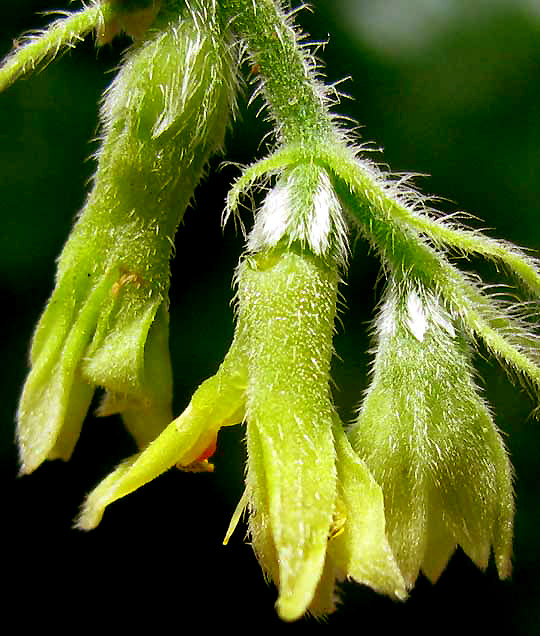Excerpts from Jim Conrad's
Naturalist Newsletter
from the July 11,, 2010 Newsletter issued from Hacienda Chichen Resort beside Chichén Itzá Ruins, central Yucatán, MÉXICO; limestone bedrock, elevation ~39m (~128ft), ~N20.676°, ~W88.569°
GRONOVIA'S HOOKED SPINES
Beside the long, straight road cutting through the scrubby forest leading to Hacienda Chichen nowadays there's an herbaceous vine with yellow flowers, shown below:

At first I thought it was one of several species of stickery "wild cucumbers" found in this area. However, this vine didn't bear the cucumbers' tendrils, so I took a closer look at the flowers. A blossom showing an inferior ovary (calyx and corolla arising above the ovary) invested with long, sharp hairs which later might develop into spines covering the fruit is shown below:

These flower details also suggested various "wild cucumber" species, yet when I compared the plant to every member of the Cucumber Family found in this area there was no match. Now I had to get technical. You can see what finally set me on the right path below:

See those tongue-shaped, orangish things? They're corolla lobes, or petals. That means that the much larger, star-shaped, yellowish white thing that looks like a corolla actually is a calyx. Most calyxes are green and inconspicuously hidden below the colorful corolla, but in this flower the calyx takes over the corolla's work. Also, it's unusual how one petal and one stamen stand side-by-side at the base of each sepal. This is all very uncucumberish.
Still, I couldn't think of anything I've ever seen like this, and drew a complete blank, until I took a close look at the hairs. You can see them below:

Those sharp hooks explain why the stems stick to your hairy legs as you push among them. There's a family containing a number of climbing herbs without tendrils, and famous for its many kinds of peculiar hairs, especially stinging and barbed ones, and that's the little known, mostly neotropical Loasa Family, the Loasaceae. Checking now for members of that family to be expected in this area, it was easy to come up with the scratchy, wild-cucumber-like vine's name.
It's GRONOVIA SCANDENS, with no English name I can find, but sometimes called Ortiguilla in Spanish. Here they call just about anything with stinging hairs "Ortiga," and "illa" is a diminutive suffix, so Ortiguilla just means "Little Ortiga." In Maya it's Laal-Mux. It's found in weedy places from Mexico through Central America into much of South America.